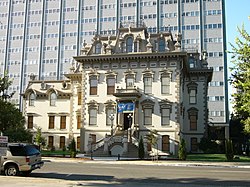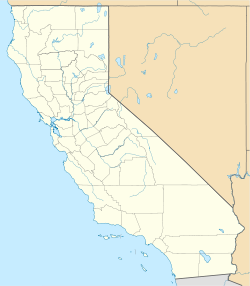Leland Stanford Mansion State Historic Park
|
Stanford-Lathrop House*
|
|

Stanford-Lathrop House
|
|
| Location | Sacramento, California |
|---|---|
| Coordinates | 38°34′34.22″N 121°29′52.38″W / 38.5761722°N 121.4978833°WCoordinates: 38°34′34.22″N 121°29′52.38″W / 38.5761722°N 121.4978833°W |
| Built | 1857 |
| Architect | Seth Babson |
| Architectural style | Second Empire |
| NRHP Reference # | 71000178 |
| CHISL # | 614 |
| Significant dates | |
| Added to NRHP | December 9, 1971 |
| Designated NHL | May 28, 1987 |
Leland Stanford Mansion State Historic Park is a state and federally protected historic site in Sacramento, California.
The park is on the corner of 8th Street and N Street in Downtown Sacramento, just two blocks away from the State Capitol building.
The State Historic Park features the Stanford Mansion, once owned by Leland Stanford, Governor of California from 1862 to 1863, U.S. Senator from 1885 to 1893, railroad tycoon, member of the Big Four and founder of Stanford University.
Prior to the reopening of the mansion, California did not have a location for the hosting of official functions for nearly 40 years. Today the mansion is frequently used by the Government of California to host foreign dignitaries. The Governor also retains an office in the mansion. Tours of the mansion are offered daily but can be impacted by official functions on behalf of the Governor's Office or the California State Legislature leadership.
The mansion was designated a California Historical Landmark in 1957 and a National Historic Landmark in 1987.
The original owner and builder of the home was Sacramento merchant Shelton C. Fogus, a wealthy Sacramento building merchant. The Renaissance Revival architecture of the original home is attributed to Seth Babson.
Leland Stanford, president of the Central Pacific Railroad and a rising member of the Republican Party, purchased the home for $8,000 in June 1861, shortly before his election as California governor that year. During his two-year governorship, the Stanford Mansion served as the state's executive office and living quarters. Succeeding governors Frederick Low and Henry Huntly Haight would also make the mansion their office.
...
Wikipedia



